$611.3 billion. According to HG’s data, 1.7M companies are projected to spend this amount on modern data infrastructure in the next 12 months. Impressive? Yes! But what does this number tell us? Beyond the sheer number of dollars, it signals how critical the data concept has become to modern organizations. Everyone wants to securely store their data and find ways to understand and manage it more effectively than their competitors. This demand results in the emergence of innovative concepts, with data democratization being one of the most impactful.
What Is Data Democratization?
Data Democratization can be described as making data accessible to every employee, regardless of their technical background. In other words, data democratization means something at the intersection of technical upgrades and a cultural shift inside the organization. The Data Democratization meaning lies in its ability to foster a culture of data-driven decision-making and transparency. Follow it, and your organization will achieve high chances to break down traditional silos and enable more informed, timely decisions.

Source: Experian Data Quality
An Experian report revealed that 81% of business leaders identified data democratization as a key initiative, highlighting the growing recognition of its importance. However, implementing democratization of data requires both the right infrastructure and strategic guidance. So, let’s discover them.
Historical Fragmentation of Data Access
Imagine that you work at a large company where each department is like its own little kingdom. Marketing has their beloved Excel spreadsheets, finance guards their fortress of Power BI reports, and R&D can’t live without their Python scripts. Each team is hoarding its data, with little overlap or sharing. Sure, it keeps things tidy for them, but for the business as a whole? It’s chaos.
For years, companies operated like this—each team building its own “data house,” complete with separate tools, formats, and standards. Why? It all came down to costs. Back when data storage was pricey, everyone had to think small. Departments focused only on what was essential for them, creating data silos—those isolated pools of information that kept each team in the dark about what the others were doing. A study even showed that nearly 60% of businesses deal with data silos, and it’s costing them both time and potential. Teams miss out on valuable insights simply because the data is scattered.
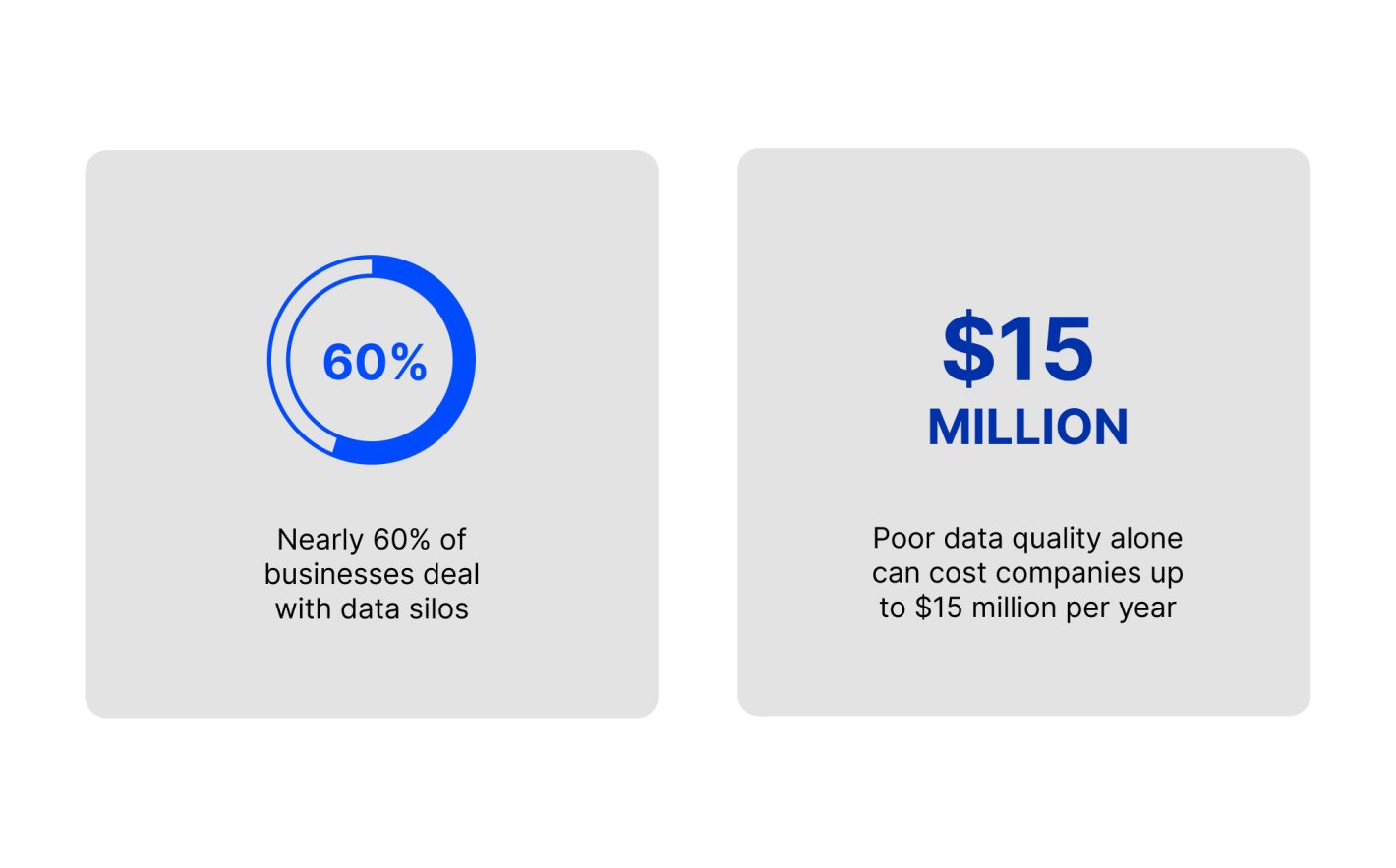
Source: Harvard Business Review, Gartner
Data silos result in redundant work and inconsistent insights. Have you ever witnessed conflicts between finance and marketing over customer numbers or sales forecasts? That’s what happens with data fragmentation. Instead of collaborating effectively, data engineers often find themselves duplicating efforts across different departments. According to Gartner, poor data quality alone can cost companies up to $15 million annually. Just imagine the compounded impact of these duplicate efforts and missed insights!
Challenges of Fragmented Data Systems
When data sits in isolated systems, it creates several annoying and costly problems. Three points describe the situation best of all:
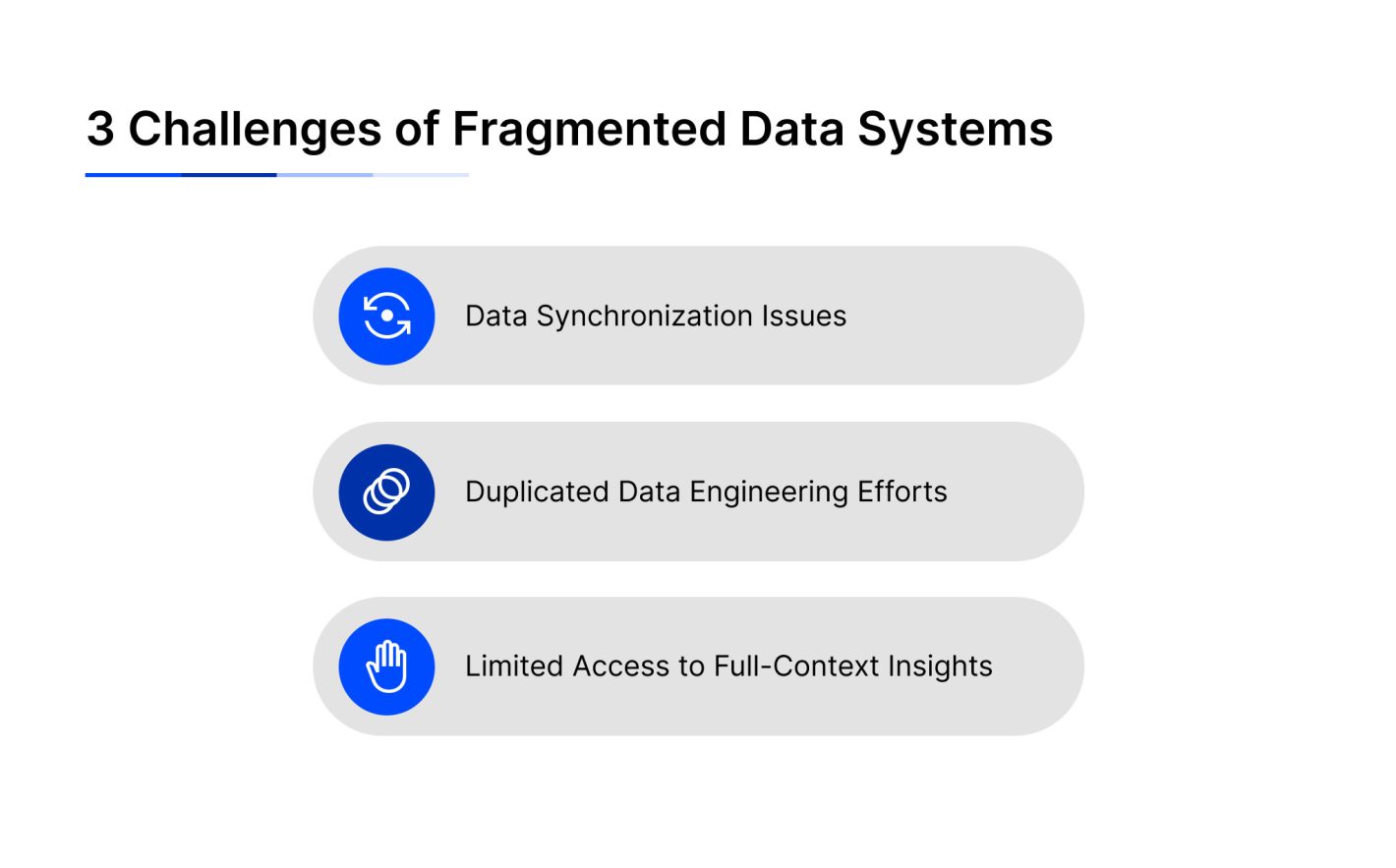
Three challenges of fragmented data systems
- Data Synchronization Issues: Since each department has its own data-cleaning and processing routines, you end up with misaligned numbers. If finance and marketing label customer segments differently, no one’s ever on the same page.
- Duplicated Data Engineering Efforts: Engineers often redo work that’s already been done elsewhere. One team’s effort to clean up a dataset doesn’t carry over to other departments, so everyone keeps reinventing the wheel.
- Limited Access to Full-Context Insights: Because data is restricted within departments, it’s impossible to get a complete view of the business. Each team only has a partial picture, missing out on insights that could spur innovation, collaboration, and efficiency.
The real impact of these challenges illustrates the number from a Forrester research, which finds that knowledge workers spend an average of 12 hours a week “chasing data.” This is precious time that could be spent on value-added work and decision-making. With cloud technology making data storage cheap and accessible, companies are breaking down those walls. The first step is to bring data together in centralized systems like data lakes or enterprise data warehouses. The second step is a shift toward a unified data fabric—an architecture where everyone can pull from the same source of truth. That’s where democratization of data comes into play.
Data Fabric as a Solution to Fragmentation
As cliché as it sounds, the first step towards democratizing your data is purely technical. As we said above, it involves building a so-called Data Fabric. This concept is like an invisible layer that connects all the different places where an organization’s data is stored, making it easy for everyone to access and use it. Think of it as a network that “weaves” together various data sources into one organized system, so employees can find, share, and analyze data without dealing with messy, isolated data silos. If you go back to the first paragraph of this article, you’ll see how the very architecture of this concept resonates with the notion of democratizing data. To learn more about this concept, we recommend reading our latest guide on different data architectures.
Such a unified approach not only dismantles traditional data silos but also standardizes data transformation and synchronization processes, fostering a more cohesive data environment.
Core Principles of Data Democratization
The next step towards your data democratization is more cultural. To effectively democratize data, organizations must adhere to three key principles:
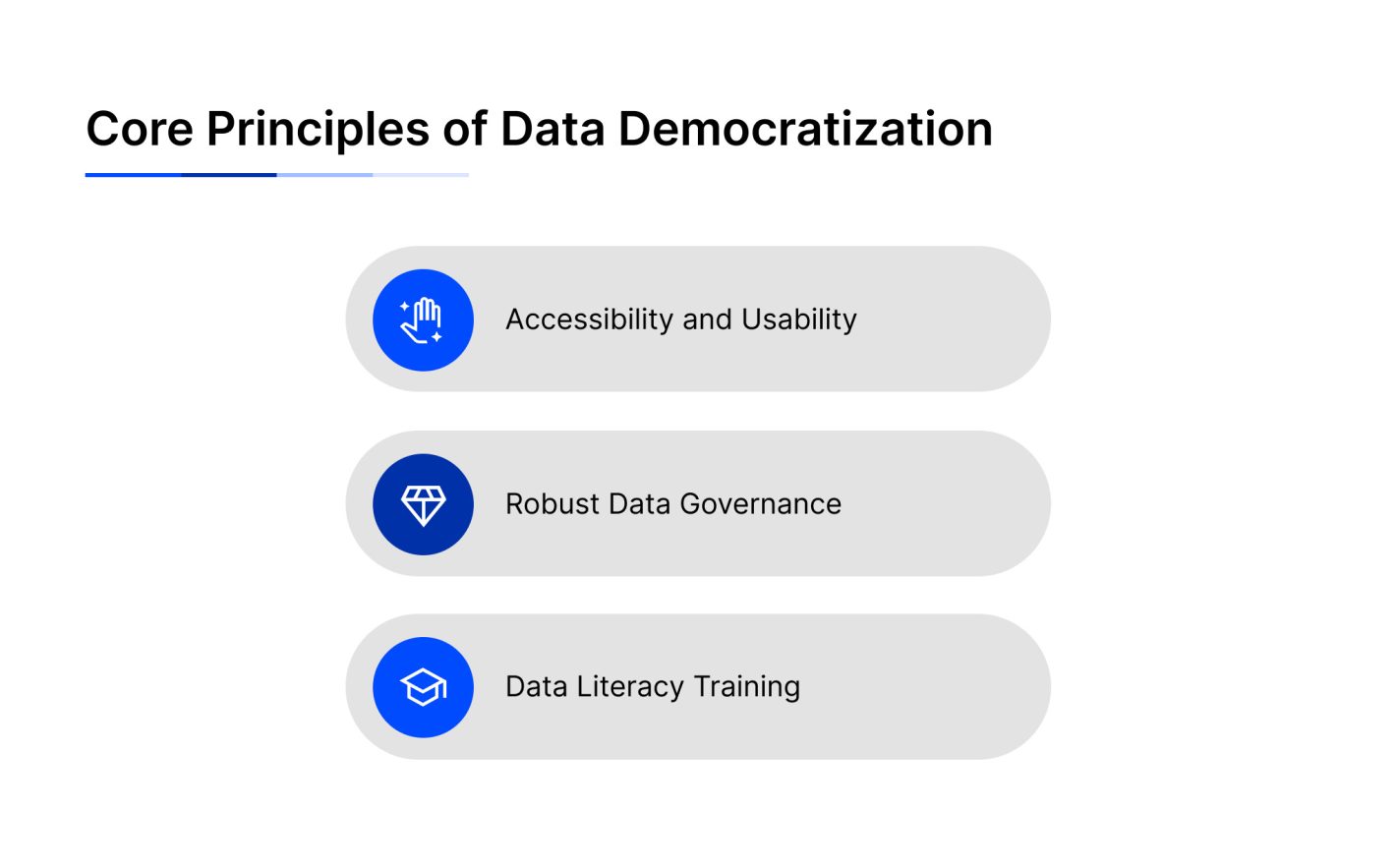
Three data democratization principles
- Accessibility and Usability: Ensuring that data is readily accessible and presented in user-friendly formats is crucial. The data democratization meaning lies in empowering every employee to make data-based decisions, regardless of their technical expertise.
- Robust Data Governance: Implementing standardized rules for data transformation and access is essential to maintain data integrity, security, and privacy. A well-defined governance framework ensures that data is used responsibly and effectively across the organization.
- Data Literacy Training: Providing comprehensive training on data processing and visualization tools equips employees with the necessary skills to interpret and utilize data effectively. This investment in data literacy enhances the organization’s overall analytical capabilities.
Following these principles, we at Sombra believe that data democratization starts with people. Thus, beyond mere infrastructure, we also provide comprehensive training and tools that help every employee confidently interpret and utilize data, fostering a sustainable, data-driven culture.
Advanced Toolkit for Data Democratization
Since data democratization is a process, let’s envision a scenario where you have replicated the infrastructure, implemented the essential practices within your team, and begun to experience the initial benefits. What comes next? Improving your system. This is where technology plays a crucial role once again—specifically, by utilizing the most advanced tools available.
For example, text-to-SQL language models and large language models simplify complex queries, allowing users to extract insights by posing questions in natural language. This accessibility reduces barriers to data usage, enabling employees without technical expertise to interact with complex datasets effectively.
Self-service business intelligence tools like Power BI, Tableau, and Looker empower users to create reports and dashboards independently. These platforms facilitate data exploration and visualization, promoting a culture of self-sufficiency and continuous learning within the organization, aligning with the data democratization definition.
Augmented analytics, powered by AI, automatically analyzes patterns and trends in data, highlighting insights for users without requiring manual effort. Augmented analytics aids non-experts by providing insights and predictions, allowing quicker and more confident data-driven decisions.
Automated data cataloging tools like Alation and Collibra are also reshaping democratization of data. These tools scan and index datasets, creating structured catalogs that make it easy for employees to find and understand data. Add Data lineage feature to your catalogs and you will achieve the possibility to track the origins, transformations, and journey of data, creating transparency that builds trust in its accuracy.
Another powerful addition is collaborative data workspaces, such as Databricks and Snowflake. These platforms allow multiple users to work on shared datasets in real time, fostering cross-functional collaboration and unifying data across departments. By enhancing data transparency and minimizing silos, collaborative workspaces empower teams to align seamlessly on insights.
Low-code and no-code platforms. Tools like Airtable and AppSheet enable users to create custom data applications or workflows without needing extensive coding knowledge. This self-service approach boosts productivity and democratizes the creation of data-driven solutions, allowing all employees to contribute to the organization’s data strategy.
Finally, Semantic models can simplify data access by organizing it into standardized, business-friendly formats, making report creation and data queries less technical. By applying a semantic layer, companies can accelerate reporting and make data accessible in terms everyone can understand, enabling teams to act quickly on insights.
As you can see, there are plenty of methods and tools available. The remaining task is to choose the right stack and strategy with the help of Sombra’s engineers.
Getting Started with Data Democratization Without Headaches
You might be wondering why a section with this title is tucked away at the very end of this article. Let us explain. The earlier sections discuss the comprehensive process of creating a unified data architecture to harness the full potential of a democratized data environment. However, what should organizations do if they are not quite ready or are still questioning what is democratization of data?
For those on the fence or unsure where to start, Sombra created a quick guide to help you take the first steps on this journey without breaking the bank.
Here are some foundational steps to simplify the process:
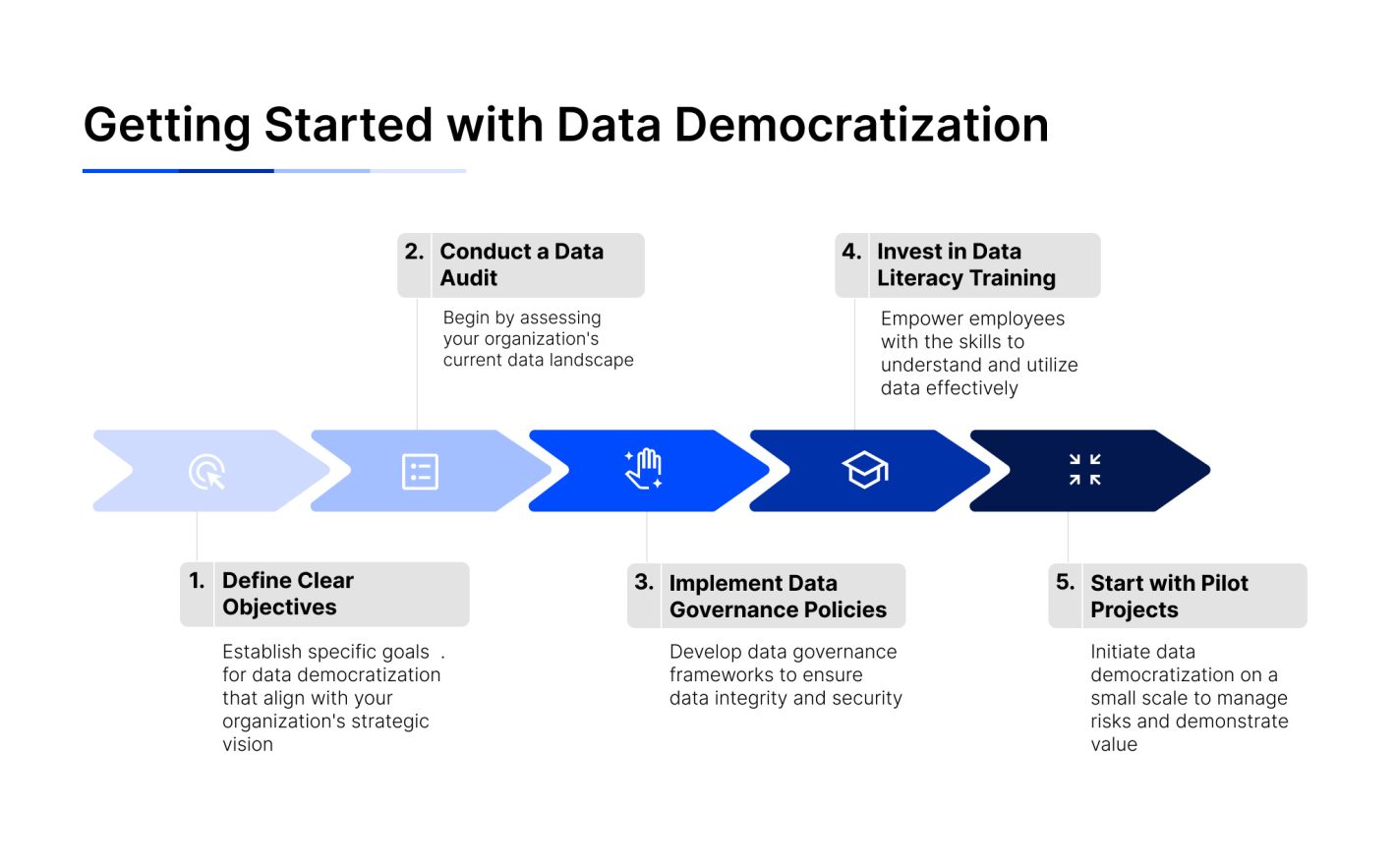
Data demoratization step-by-step
1. Define Clear Objectives
Establish specific goals for data democratization that align with your organization’s strategic vision. What do you need?
- Enhanced Decision-Making: Enable data-driven decisions across all levels.
- Improved Collaboration: Foster cross-departmental data sharing and cooperation.
- Increased Efficiency: Streamline data access to reduce redundancy and accelerate workflows.
Clear objectives guide the implementation process and help measure success.
2. Conduct a Data Audit
Begin by assessing your organization’s current data landscape:
- Inventory Data Assets: Catalog all data sources, noting their locations, formats, and accessibility.
- Identify Data Owners: Determine who manages each dataset and their roles in data governance.
- Evaluate Data Quality: Assess the accuracy, completeness, and consistency of your data.
This audit provides a clear understanding of your starting point and highlights areas needing improvement.
3. Implement Data Governance Policies
Develop data governance frameworks to ensure data integrity and security:
- Standardize Data Management: Create consistent procedures for data collection, storage, and usage.
- Assign Responsibilities: Define roles for data stewardship and accountability.
- Ensure Compliance: Adhere to relevant data protection regulations and industry standards.
Effective governance balances open access with necessary controls.
4. Invest in Data Literacy Training
Empower employees with the skills to understand and utilize data effectively:
- Offer Training Programs: Provide workshops and courses on data analysis and interpretation.
- Promote a Data-Driven Culture: Encourage curiosity and the use of data in everyday decision-making.
- Provide User-Friendly Tools: Equip staff with intuitive analytics platforms that require minimal technical expertise.
Building data literacy ensures that democratized data leads to meaningful insights.
5. Start with Pilot Projects
Initiate data democratization on a small scale to manage risks and demonstrate value:
- Select a Department or Team: Choose a group with a clear need for improved data access.
- Set Measurable Goals: Define success metrics to evaluate the pilot’s impact.
- Gather Feedback: Use insights from the pilot to refine strategies before broader implementation.
Pilot projects provide practical insights and build momentum for organization-wide adoption.
By following these steps, organizations can lay a foundation for democratization of data as well as understand the further steps in this data path.
Benefits of a Democratized Data Environment
When data democratization is fully implemented across an organization, the benefits can be game-changing. Think of a unified data ecosystem as the backbone of modern decision-making. With streamlined, democratized data, companies aren’t just making faster choices—they’re making smarter, more strategic ones. Research indicates that companies with high levels of data democratization are 2.5 times more likely to achieve significant business outcomes, such as improved operational efficiency and enhanced customer engagement. In a landscape where up to 70% of organizational data remains unanalyzed, this could be a game changer.
Here’s a breakdown of some core advantages a democratized data environment can offer:
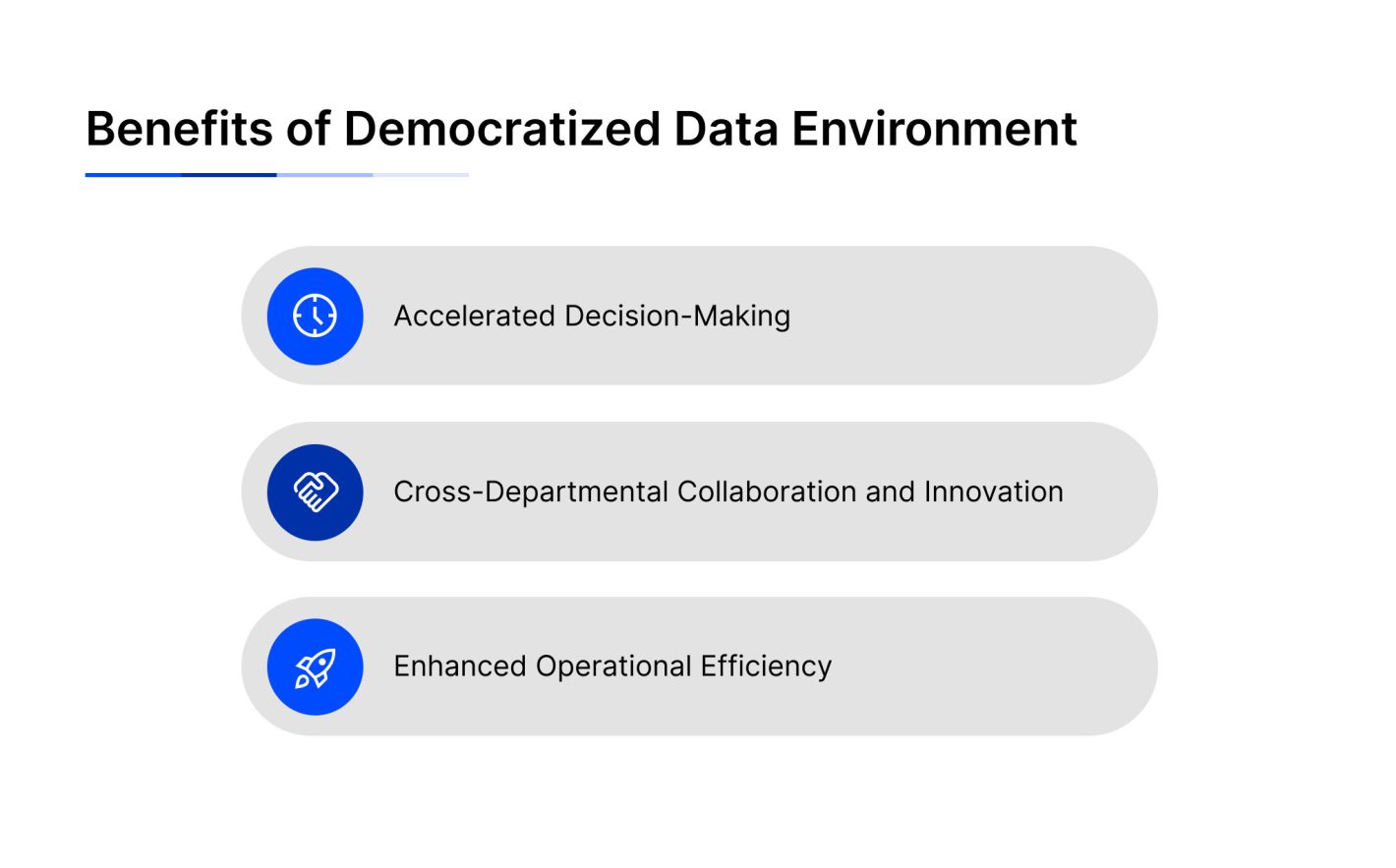
Three benefits of democratized data
- Accelerated Decision-Making: With real-time data accessible to every team, decisions don’t get bottlenecked, waiting for insights to trickle down from data specialists. Everyone has access to the same data, allowing for quicker, more agile responses to emerging market trends or operational changes.
- Cross-Departmental Collaboration and Innovation: When data is democratized, barriers between departments dissolve. Marketing can learn from sales trends, and operations can incorporate insights from finance. Organizations with integrated data systems reported 50% more cross-departmental collaboration, leading to innovative solutions and improved productivity.
- Enhanced Operational Efficiency: With a shared data environment, companies eliminate the costly redundancies created by siloed data systems. A centralized data source means teams aren’t duplicating work—data engineers aren’t redoing tasks, and analysts don’t have to chase down different data sets to make sense of trends. This improved workflow can lead to efficiency gains, potentially saving millions annually on redundant data processes.
Case Studies
- Netflix attributes its success in part to a culture of data democratization, allowing employees across the organization to access and utilize data for decision-making, leading to more personalized content recommendations and improved customer satisfaction. Databricks
- Airbnb implemented a data democratization strategy that enabled employees to access data and insights, resulting in a 30% increase in the speed of decision-making processes. FullStory
Conclusion: Prepare for a Journey
At the heart of data democratization lies the idea that data is not the privilege of a few specialists. It’s a shared resource for the entire organization that will help you stay ahead in a competitive race.
In practical terms, data democratization means investing in infrastructure like Data Fabric to unify fragmented systems. You need to establish strong data governance for security and accuracy and adopt tools like LLMs and data catalogs to make data access easier for everyone.
However, the most important part of this transformation is building a data-literate culture. With training and support, companies can empower employees not just to use data but to interpret it with confidence and insight.
Understanding the data democratization definition could be the key to your organization’s success, and Sombra is ready to start this journey with you. Let’s create a culture where data empowers everyone.











